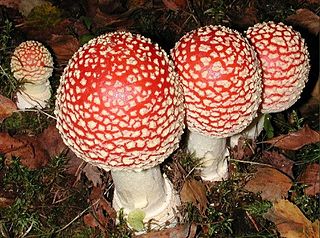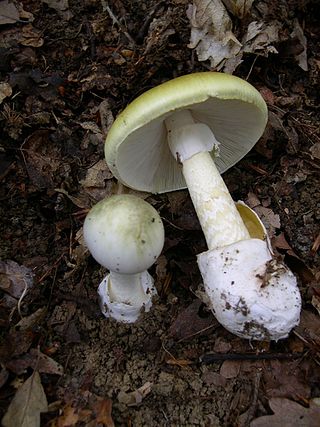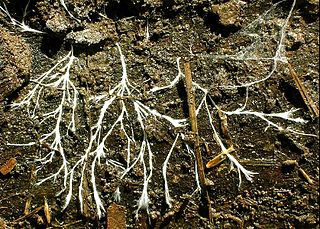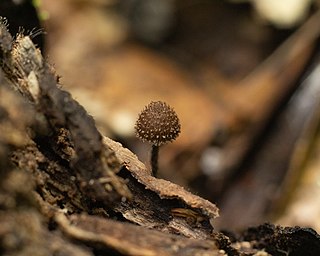
Mycology is the branch of biology concerned with the study of fungi, including their taxonomy, genetics, biochemical properties, and use by humans. Fungi can be a source of tinder, food, traditional medicine, as well as entheogens, poison, and infection. Mycology branches into the field of phytopathology, the study of plant diseases. The two disciplines are closely related, because the vast majority of plant pathogens are fungi. A biologist specializing in mycology is called a mycologist.

A mycorrhiza is a symbiotic association between a fungus and a plant. The term mycorrhiza refers to the role of the fungus in the plant's rhizosphere, its root system. Mycorrhizae play important roles in plant nutrition, soil biology, and soil chemistry.

A truffle is the fruiting body of a subterranean ascomycete fungus, predominantly one of the many species of the genus Tuber. In addition to Tuber, over one hundred other genera of fungi are classified as truffles including Geopora, Peziza, Choiromyces, and Leucangium. These genera belong to the class Pezizomycetes and the Pezizales order. Several truffle-like basidiomycetes are excluded from Pezizales, including Rhizopogon and Glomus. Truffles are ectomycorrhizal fungi, so they are usually found in close association with tree roots. Spore dispersal is accomplished through fungivores, animals that eat fungi. These fungi have significant ecological roles in nutrient cycling and drought tolerance.

The opisthokonts are a broad group of eukaryotes, including both the animal and fungus kingdoms. The opisthokonts, previously called the "Fungi/Metazoa group", are generally recognized as a clade. Opisthokonts together with Apusomonadida and Breviata comprise the larger clade Obazoa.

Mushroom poisoning is poisoning resulting from the ingestion of mushrooms that contain toxic substances. Symptoms can vary from slight gastrointestinal discomfort to death in about 10 days. Mushroom toxins are secondary metabolites produced by the fungus.

Pleurotus ostreatus, the oyster mushroom, oyster fungus, hiratake, or pearl oyster mushroom is a common edible mushroom. It is one of the more commonly sought wild mushrooms, though it can also be cultivated on straw and other media.

Pleurotus is a genus of gilled mushrooms which includes one of the most widely eaten mushrooms, P. ostreatus. Species of Pleurotus may be called oyster, abalone, or tree mushrooms, and are some of the most commonly cultivated edible mushrooms in the world. Pleurotus fungi have also been used in mycoremediation of pollutants, such as petroleum and polycyclic aromatic hydrocarbons.

Saprotrophic nutrition or lysotrophic nutrition is a process of chemoheterotrophic extracellular digestion involved in the processing of decayed organic matter. It occurs in saprotrophs, and is most often associated with fungi and soil bacteria. Saprotrophic microscopic fungi are sometimes called saprobes. Saprotrophic plants or bacterial flora are called saprophytes, although it is now believed that all plants previously thought to be saprotrophic are in fact parasites of microscopic fungi or other plants. In fungi, the process is most often facilitated through the active transport of such materials through endocytosis within the internal mycelium and its constituent hyphae.

A fungus is any member of the group of eukaryotic organisms that includes microorganisms such as yeasts and molds, as well as the more familiar mushrooms. These organisms are classified as one of the traditional eukaryotic kingdoms, along with Animalia, Plantae and either Protista or Protozoa and Chromista.

Ripartitella is a genus of fungi in the family Agaricaceae. The genus was circumscribed by Rolf Singer in Mycologia vol.39 on page 85 in 1947.

Pleurocybella porrigens is a species of fungus in the family Phyllotopsidaceae. The species is widespread in temperate forests of the Northern Hemisphere. P. porrigens, known as the angel wing, is a white-rot wood-decay fungus on conifer wood, particularly hemlock. The flesh is thin and fragile compared to the oyster mushrooms.

Hypsizygus is a small genus of fungi that are widely distributed in north temperate regions. The genus was circumscribed by Rolf Singer in 1947. The common name for Hypsizygus ulmarius is the elm oyster mushroom.

Cystoagaricus is a genus of fungi in the family Psathyrellaceae. The genus contains four species found in subtropical America. The genus was circumscribed by mycologist Rolf Singer in 1947, with Cystoagaricus strobilomyces as the type species.

Gilled fungi with laterally-attached fruiting bodies are classified as pleurotoid. Pleurotoid fungi are typically wood-decay fungi and are found on dead and dying trees and coarse woody debris. The pleurotoid form is polyphyletic, having evolved a number of times within the Basidiomycota. Many species of pleurotoid fungi are commonly referred to as "oyster" mushrooms. Laterally-attached fungi with pores rather than gills are referred to as bracket fungi.

Pleurocybella ohiae is a species of agaric fungus in the family Phyllotopsidaceae. Newly described to science in 2011, it is known only from Hawaiian montane wet forests.

Cystoagaricus strobilomyces is a species of mushroom producing fungus in the family Psathyrellaceae and the type species of the Cystoagaricus genus
















